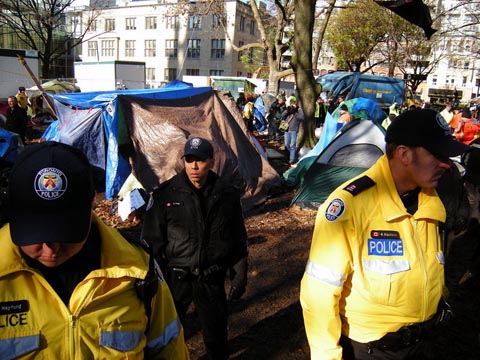If there was one word that could sum up the Occupy Toronto eviction it would be “painstaking.”
The enforcement of the trespass order started at roughly 6 a.m. and took 12 hours over the course of Wednesday. The Occupy Toronto camp stood for 40 days in St. James Park in downtown Toronto. In that time, the Occupy movement held scores of general assemblies, hundreds of smaller meetings, many workshops, rallies and protest marches and countless personal conversations between people.
Around noon, hundreds of trade unionists from the Ontario Federation of Labour convention marched to St. James Park to show their solidarity with Occupy Toronto. Many unionists stood on a muddy hill in the park blocked by a police line as they watched police slowly remove protesters from a fire pit (formally the location of the sacred fire) and shouted messages of solidarity.
In a contrast to the fast and violent repression at the G20, the Toronto police preferred negotiations, sometimes talking with people for hours to try and reach a peaceful resolution.
However, police did use force against people holding out at various points in the park and who refused to leave structures that they had erected as makeshift barricades. During the arrest of one woman, she could be heard shouting “Don’t touch me” and then screaming in pain from 30 metres away. Police also forcefully removed four people from the library yurt who refused to leave. In total there were 11 arrests made with most people being released with trespass tickets after being processed in a mobile command centre on the corner of the park.
“They dragged me pretty roughly, I didn’t resist, but they don’t go easy. It hurt my groin area. Especially when they lift your entire body weight by your groin, obviously that doesn’t feel good. That’s part of what the police do, they’re violent,” said Brandon Gray, 31, who had chained himself to the library yurt and refused to leave.
However, for the most part the negotiations were successful and the take down of the tents was orderly if slow. Some occupiers took down their tents and where tents were empty city workers took them down, putting numbered tags on them for identification and putting them in clear plastic bags that were taken away by city trucks. All of the large yurts (a type of Mongolian tent made for winter conditions) donated by trade unions were taken down by the end of the day and taken to storage.
According to union members on site the management had targeted workers, such as those near retirement, who they thought would be vulnerable to threats of discipline for refusing to clear the camp. There was also a reported high manager-to-worker ratio that some unionists speculated was to create an intimidating atmosphere for the workers and ensure their compliance.
Cory Weir, 24, voluntarily left the library yurt with others after reaching an agreement with the Toronto Police that saw the removal of the books inside passed in a human chain and boxed by people from Occupy Toronto. “I think it’s personally a G20 apology and a PR mess that they (the police) had to deal with it this way. At the same time, they’re our brothers and sisters and they’re part of the 99 per cent that’s being affected by the cuts and inequality in society. Hopefully they’ll stand with us one day.”
When asked about cuts to the public library system, Weir said: “As soon as you start to cut funding for knowledge it’s disgusting. Knowledge is our way to enlighten ourselves and move forward in society and progress as humanity. As soon as you start hanging an axe over it and throwing budget cuts that’s ridiculous. But people who make millions of dollars every year? They get tax cuts while our public services suffer. That’s not right.”
Jordon Walsh, an Occupy Toronto protester from the library yurt, said: “I spoke to a librarian last night who was very impressed with what we were doing.”
Inspector Gary Meissner from 51 division, who was the site commander for the clearing of the park, said “We’ve demonstrated we’re committed to a peaceful resolution to this event. We provided plenty of opportunity and notification and we’re happy with the conduct of both sides today. We’re satisfied that we’ve respected the right to free speech and that we’ve allowed you the opportunity to exercise that right.”
What’s next for Occupy is anyone’s guess but now that the movement is no longer centred in St. James Park the possibilities seem wide open again. Late that night at a general assembly in front of Toronto City Hall one woman pointed out, “We’re not in the park anymore. But this conversation is very much alive.”
On Thursday, Nov. 24, the Ontario Federation of Labour will be marching on the financial district with Occupy Toronto and Occupy activists from other cities. If activists can’t occupy a public park any longer, it looks like they will take their message back to Bay Street, the corporate headquarters of Canada’s one per cent.
Mick Sweetman is rabble.ca’s news intern.



